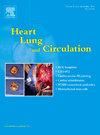Functional Coronary Angiography for the Diagnosis of Coronary Vasomotor Disorders
IF 2.2
4区 医学
Q2 CARDIAC & CARDIOVASCULAR SYSTEMS
引用次数: 0
Abstract
Microvascular and/or vasospastic angina are two common forms of coronary vasomotor disorders that may occur in patients with ischaemia and non-obstructed coronary arteries (INOCA) or myocardial infarction with non-obstructive coronary arteries (MINOCA). Functional coronary angiography involves invasive guidewire-based assessment of the coronary circulation using pharmacological vasoactive agents to assess small and large vasomotor dysfunction. Typically, responses to adenosine (microvascular vasodilator) and acetylcholine (large and small vessel vasospastic agent) are sequentially assessed. Currently, the assessment and treatment of INOCA and MINOCA patients varies widely. We therefore provide a standard protocol for ‘functional coronary angiography’ for use in Australia and New Zealand. Ischaemic heart disease (IHD) due to disorders of coronary vasomotion causes angina and impairs quality of life and prognosis. INOCA is prevalent in both men and women, however relative to obstructive CAD, INOCA is over-represented in women. This may also be a relevant contributor to sex differences which persist in IHD outcomes (notably in young women).
Recent European Society of Cardiology guidelines make a class I recommendation in support of the use of functional coronary angiography in INOCA. Despite this, testing for disorders of coronary vasomotion is performed in very few centres in Australia and New Zealand. Barriers to more widespread clinical adoption include the lack of a standard protocol for testing, additional time and training required, lack of funding, concerns over safety and physician knowledge pertaining to over diagnosis and treatment options. Taken together, it is not surprising that local prevalence and outcome data are lacking. We summarise indications for functional assessment of coronary vasomotor disorders with a simple standardised operating protocol for use in cardiac catheter laboratories throughout Australia and New Zealand. We provide guidance on training recommendations for clinical proficiency in undertaking and interpreting functional coronary angiography. Clinical performance and research will be enhanced with the establishment of a national clinical quality registry for functional coronary angiography. By unifying the clinical approach, we hope to facilitate better care for this frequently overlooked heterogenous group of patients.
功能性冠状动脉造影诊断冠状动脉血管舒缩性疾病。
微血管和/或血管痉挛性心绞痛是两种常见的冠状动脉血管舒张性疾病,可能发生在缺血和非阻塞性冠状动脉(INOCA)或心肌梗死合并非阻塞性冠状动脉(MINOCA)的患者中。功能性冠状动脉造影包括利用血管活性药物对冠状动脉循环进行侵入性评估,以评估小血管和大血管舒缩功能障碍。通常,依次评估对腺苷(微血管血管扩张剂)和乙酰胆碱(大血管和小血管痉挛剂)的反应。目前,对INOCA和MINOCA患者的评估和治疗存在很大差异。因此,我们为澳大利亚和新西兰提供了“功能性冠状动脉造影”的标准方案。缺血性心脏病(IHD)由冠状动脉血管舒张障碍引起心绞痛,影响生活质量和预后。INOCA在男性和女性中都很普遍,然而相对于阻塞性CAD, INOCA在女性中有过多的代表。这也可能是IHD结果中持续存在的性别差异(尤其是年轻女性)的一个相关因素。最近的欧洲心脏病学会指南提出了一级推荐,支持在INOCA中使用功能性冠状动脉造影。尽管如此,在澳大利亚和新西兰,很少有中心进行冠状动脉血管舒张性疾病的检测。阻碍临床更广泛采用的障碍包括缺乏标准的检测方案、需要额外的时间和培训、缺乏资金、对安全性的担忧以及与过度诊断和治疗方案有关的医生知识。综上所述,缺乏当地流行率和结果数据并不奇怪。我们总结了冠状动脉血管舒缩性疾病功能评估的适应症,采用简单的标准化操作方案,用于整个澳大利亚和新西兰的心导管实验室。我们提供指导培训建议临床熟练进行和解释功能性冠状动脉造影。随着功能性冠状动脉造影国家临床质量登记的建立,临床表现和研究将得到加强。通过统一临床方法,我们希望能更好地照顾这一经常被忽视的异质性患者群体。
本文章由计算机程序翻译,如有差异,请以英文原文为准。
求助全文
约1分钟内获得全文
求助全文
来源期刊

Heart, Lung and Circulation
CARDIAC & CARDIOVASCULAR SYSTEMS-
CiteScore
4.50
自引率
3.80%
发文量
912
审稿时长
11.9 weeks
期刊介绍:
Heart, Lung and Circulation publishes articles integrating clinical and research activities in the fields of basic cardiovascular science, clinical cardiology and cardiac surgery, with a focus on emerging issues in cardiovascular disease. The journal promotes multidisciplinary dialogue between cardiologists, cardiothoracic surgeons, cardio-pulmonary physicians and cardiovascular scientists.
 求助内容:
求助内容: 应助结果提醒方式:
应助结果提醒方式:


